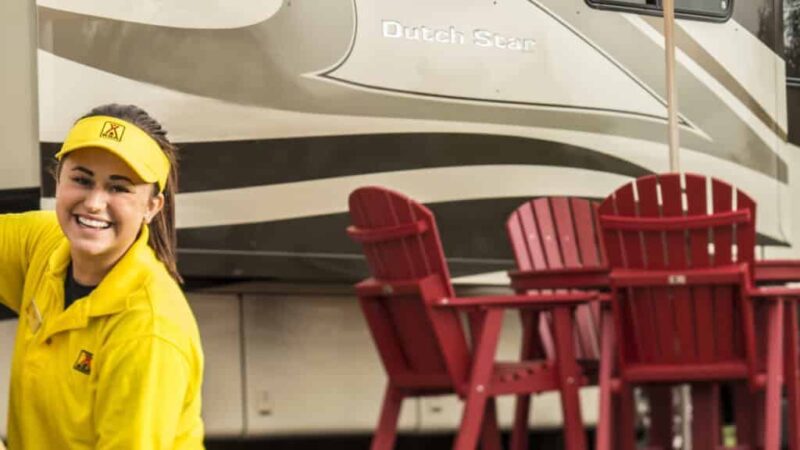A Battery Of Information
By Steve Froese, F276276
A plethora of information regarding lithium-ion (li-ion) batteries is available online, but not all of it is accurate. So, I thought I’d provide an overview to educate readers on the basics, as well as the pros and cons of li-ion batteries. This article will serve as a primer only and will not go into detail about lithium-ion technology. My goal is to provide you valuable information to help you decide whether to purchase this technology for your RV. Should you have additional questions after reading this, please don’t hesitate to email me at [email protected].
Several different types of chemistry are used for li-ion batteries, but the one most common to batteries made for RV applications is lithium iron phosphate (LiFePO4). If this article convinces you to give lithium batteries a try, you will most likely be purchasing LiFePO4 technology. This is the recommended type for RV and other recreational use.
The first thing most people notice about li-ion technology is the purchase price. Lithium batteries generally cost in excess of $1,000 per 100 ampere-hour (Ah). This compares to a few hundred dollars for regular flooded lead acid (FLA) batteries, a category that includes sealed lead acid, gel, and absorbed glass mat batteries. However, the total cost of ownership is generally much lower for li-ion batteries. FLA batteries typically last a few thousand cycles, whereas li-ion batteries can endure tens of thousands of cycles.
While I do understand that the original cash outlay is a key consideration, it is also important to think about total cost of ownership over the significant life of the li-ion battery (battery longevity will depend on several factors, such as brand quality). I should note that if you seldom camp off-grid, li-ion batteries may not be a good investment. So, if you rarely or never rely on your house batteries for power, that should be part of your evaluation.
The second difference between sealed lead acid (SLA) and li-ion batteries is useful depth of cycle range. SLA deep-cycle batteries commonly used for RV house batteries have a useful cycle depth of 50 percent. Sustained deep cycling of the batteries below 50 percent of their rated capacity will degrade their performance and life expectancy. Most 6-volt SLA batteries have a rating of approximately 220 amp-hours (Ah), which means they can provide 220 amps (A) for one hour. However, since SLA batteries have a useful cycle depth of 50 percent, one can utilize only 110Ah of power from a single SLA battery. 12-volt SLA batteries are generally in the range of 200Ah capacity, but using the same logic, these batteries have a useful capacity of only 100Ah.
Li-ion batteries, on the other hand, generally can be cycled down 100 percent — to 0Ah — without degradation before being recharged. This means li-ion batteries deliver twice the useful current as identically rated SLA batteries. For example, a four-battery series-parallel setup of 6-volt batteries yields a current capacity of 440Ah. Based on the 50 percent useful range, this configuration yields a total useable power of 220Ah. Considering that lithium batteries can deliver their full current rating, a single 200Ah li-ion battery will provide almost the same amount of useful power as four 6-volt SLA batteries.
Lithium batteries are the same size as their SLA counterparts; however, li-ion batteries weigh about half as much. Therefore, since an RV requires half the number of li-ion batteries to deliver the same power, this results in the total li-ion battery weight being one-quarter of the equivalent SLA setup.
In the above example, it was noted that a single li-ion battery could replace a bank of four SLA batteries; this also eliminates all battery jumper connections. I installed a single 200Ah li-ion battery in my RV to replace four 6-volt SLA batteries. Li-ion batteries can be installed in any orientation, and they do not off-gas, so they don’t require venting if installed in the living area of an RV.
The life expectancy and increased current delivery properties of li-ion batteries are compelling reasons to consider li-ion, but there are a few minor drawbacks one should consider.
First, li-ion batteries do not charge well at temperatures below freezing. If the core temperature of the li-ion battery drops below freezing, charging will not occur until the core temperature warms up above freezing again. Be aware, though, that this refers to the internal temperature of the battery and not the ambient case temperature. Because of this, several lithium battery manufacturers incorporate heaters into the batteries to help prevent charging lockup in cold weather. If you regularly camp in subzero temperatures, this may be a consideration.
A second drawback to li-ion batteries is the requirement for specialized charging systems. Consider the three battery charging systems used in RVs: converter/inverter, solar, and alternator. Converters, inverters, and solar controllers should either be new enough to support li-ion battery technology or should be upgraded to allow for lithium charging curves, which are markedly different from those of SLA batteries. Vehicle alternators need to be protected from damage that can occur because li-ion batteries absorb much higher charging current than SLA batteries. Therefore, properly installing li-ion batteries in your RV involves additional expense for the suggested charging devices. The good news is that most li-ion batteries incorporate built-in charge controllers that minimize the need for highly specialized charging equipment. It is always recommended, however.
As mentioned, if you are seriously considering upgrading your RV to lithium batteries, feel free to email me if you have specific questions. Also be sure to ask lots of questions of the battery supplier and make sure they know the answers. Ensure they provide the same explanations as I have given here. Not all li-ion batteries are created equally (and they are certainly not all high quality). FMCA has strong relationships with both Battle Born Batteries and Briter Products, two brands that use high-quality li-ion technology.
The hope is that this primer has provided you with useful basic information regarding lithium batteries and answered some of the questions you may have. Of course, there are many other features to this technology, but I have covered the main ones here.
The post A Battery Of Information appeared first on Family RVing Magazine.
Source: https://familyrvingmag.com/2024/06/19/a-battery-of-information/



